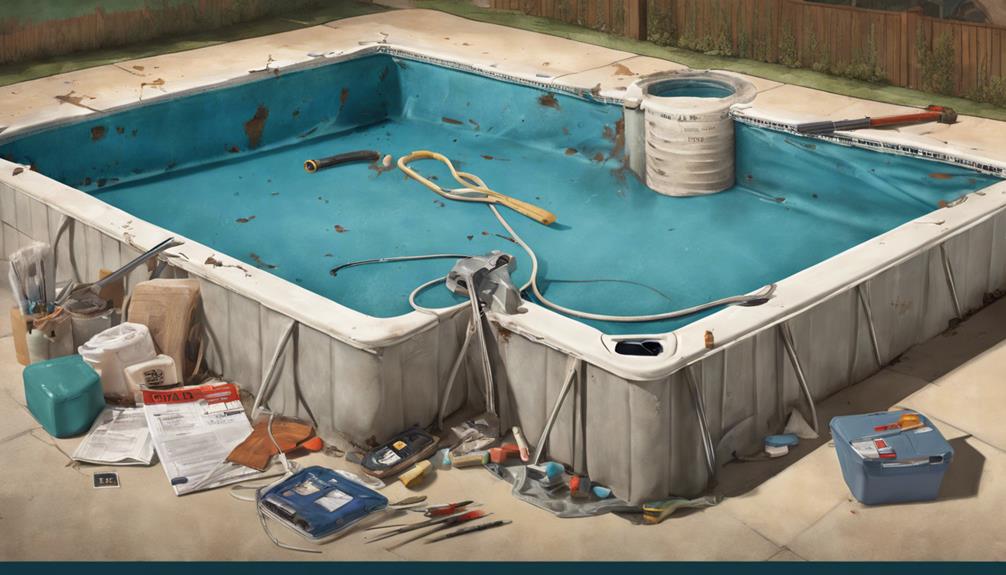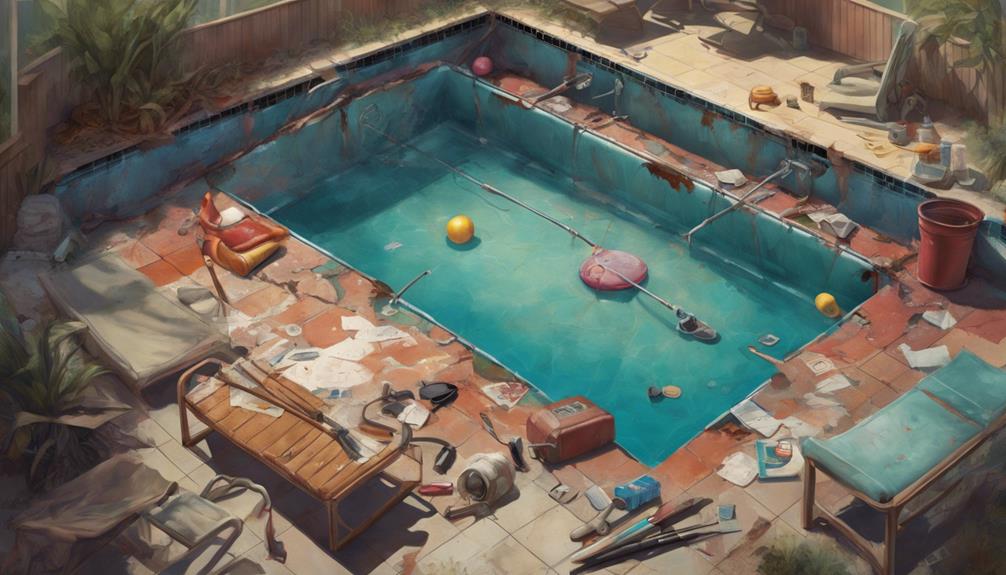When determining whether to repair or replace your pool cover, carefully observe signs of wear like fading and fraying, while also taking note of functionality issues such as sagging or reduced UV protection. Addressing simple fixes like tears and loose straps can help prolong the lifespan of the cover, but it’s important to consider the impact of age. Assess the cost-effectiveness of repairs versus investing in a new cover for ongoing protection. Thoroughly examining and understanding the factors involved will assist you in making a decision that will ensure your pool cover effectively serves its purpose for years to come.
Key Takeaways
- Regular inspection detects wear early, aiding in repair decisions.
- Consider repair for minor damages to extend cover lifespan.
- Age impacts cover integrity; new covers guarantee continued protection.
- Financial analysis crucial in repair vs. replace decisions.
- Opting for repairs can be cost-effective but monitor for unseen deterioration.
Signs of Wear and Tear
Exposure to sunlight, rain, wind, and debris gradually deteriorates pool covers, leading to visible signs of wear and tear. Fading, fraying edges, and irreparable holes are common indications of degradation. These signs not only impact the aesthetics but also compromise the functionality of the cover.
Regular inspection is critical to detect wear early on, allowing for timely intervention. Extensive damage signifies the need for immediate replacement to guarantee continued protection of the pool. By addressing wear and tear promptly, pool owners can prolong the lifespan of their covers and maintain a higher level of performance.
Monitoring these visible signs enables proactive maintenance, ultimately saving costs in the long run.
Functionality Issues to Watch For
Regular monitoring of pool covers is vital to detect functionality issues that may compromise their performance over time. Beyond debris prevention, pool covers play important roles in maintaining water temperature and guaranteeing safety. Signs of functionality problems include noticeable sagging, which indicates a loss of tautness necessary for proper coverage.
Sunlight penetration through the cover suggests a decline in its ability to block UV rays effectively. When a pool cover fails to fulfill these important functions, replacement becomes necessary to uphold the cover's primary purposes.
Consider Repairing Simple Fixes

When evaluating minor damages on a pool cover, homeowners can consider repairing simple fixes to extend its lifespan and functionality. Minor issues such as tears, loose straps, or damaged grommets can often be easily repaired.
Through a meticulous examination, it is possible to identify localized damage that is suitable for repair. By addressing these small damages promptly, homeowners can prolong the life of the cover and maintain its effectiveness.
Repairing simple fixes also proves to be a cost-effective solution compared to an outright replacement. Opting for repairs where applicable can be a practical approach to keep the pool cover functional and efficient, saving both time and money in the long run.
Age and Time Factor
Considering the longevity and effectiveness of pool covers, it is crucial to acknowledge the impact of age and time on their performance and maintenance requirements. Even durable materials deteriorate over time, compromising the cover's integrity and protective capabilities. Pool covers that have been in use for a decade or more may exhibit unseen deterioration, making them less effective in safeguarding the pool. Investing in a new cover becomes essential to guarantee continued protection. Below is a table summarizing the key points regarding the age and time factor:
| Age and Time Factor |
|---|
| Deterioration of materials over time |
| Need for replacement after a decade or more |
| Unseen deterioration compromising cover integrity |
| Decreased effectiveness in protecting the pool |
| Investment in a new cover for guaranteed protection |
Cost Analysis: Repair Vs. Replacement

It is vital to carefully assess the financial implications when deciding between repairing or replacing a pool cover. While repairs may initially seem cost-effective, they can accumulate expenses over time, especially with older covers requiring frequent fixes. Additionally, ongoing repairs can compromise pool cover safety, as a damaged or deteriorating cover may not provide adequate protection for children or pets. In contrast, investing in a new pool cover may result in higher upfront costs but can ultimately save money in the long run by reducing the need for constant repairs and ensuring optimal safety for your pool. Therefore, it is important to weigh both the financial and safety implications when making a decision.
Repairing minor damages can extend the cover's life and be a more economical choice for localized issues like tears or damaged grommets. However, aging covers may suffer from unseen deterioration, compromising their effectiveness in protecting the pool. In such cases, investing in a new cover guarantees continued protection and peace of mind.
Thus, it is important to weigh the long-term benefits of a new cover against ongoing repair costs, aligning the decision with budget considerations and future needs.
Frequently Asked Questions
Can Pool Covers Be Repaired Multiple Times Before Needing Replacement?
Pool covers can undergo multiple repairs before requiring replacement. Regular inspections reveal repairable damages like tears or loose straps. Repairing minor issues extends cover life, offering a cost-effective solution. However, aging covers may eventually need replacement for continued pool protection.
How Often Should Pool Covers Be Inspected for Wear and Tear?
Regular inspection of pool covers for wear and tear is crucial to maintain continued protection. Inspecting covers at least once every season helps identify signs of damage like fading, fraying edges, and holes, enabling timely repair or replacement.
Are There DIY Repair Kits Available for Pool Cover Damages?
In the domain of pool cover maintenance, DIY repair kits offer a convenient solution for minor damages. These kits equip pool owners with resources to address tears, loose straps, and damaged grommets efficiently, extending the cover's lifespan.
Can a Professional Assess if a Cover Is Repairable or Needs Replacement?
A professional assessment can determine if a pool cover is repairable or requires replacement. Through thorough examination, experts identify damage extent and integrity. This evaluation guarantees ideal decision-making regarding cost-efficiency and long-term protection for pool owners.
Is It Advisable to Repair a Pool Cover Close to Its Replacement Age?
It is advisable to assess the pool cover's condition thoroughly before deciding on repairs close to its replacement age. Consider functionality, extent of damage, cost analysis, and long-term benefits to make an informed choice aligned with budget and pool protection goals.
Conclusion
To sum up, maneuvering the pool cover dilemma demands a sharp eye for signs of wear and tear, functionality issues, and consideration of age and time factors.
Simple fixes may be adequate for minor damages, but extensive wear may necessitate cover replacement for ongoing protection.
Performing a cost analysis is crucial to make a well-informed decision that fits within budget limitations and long-term advantages.
Ultimately, proactive maintenance is crucial in guaranteeing the safety and longevity of pool covers.










